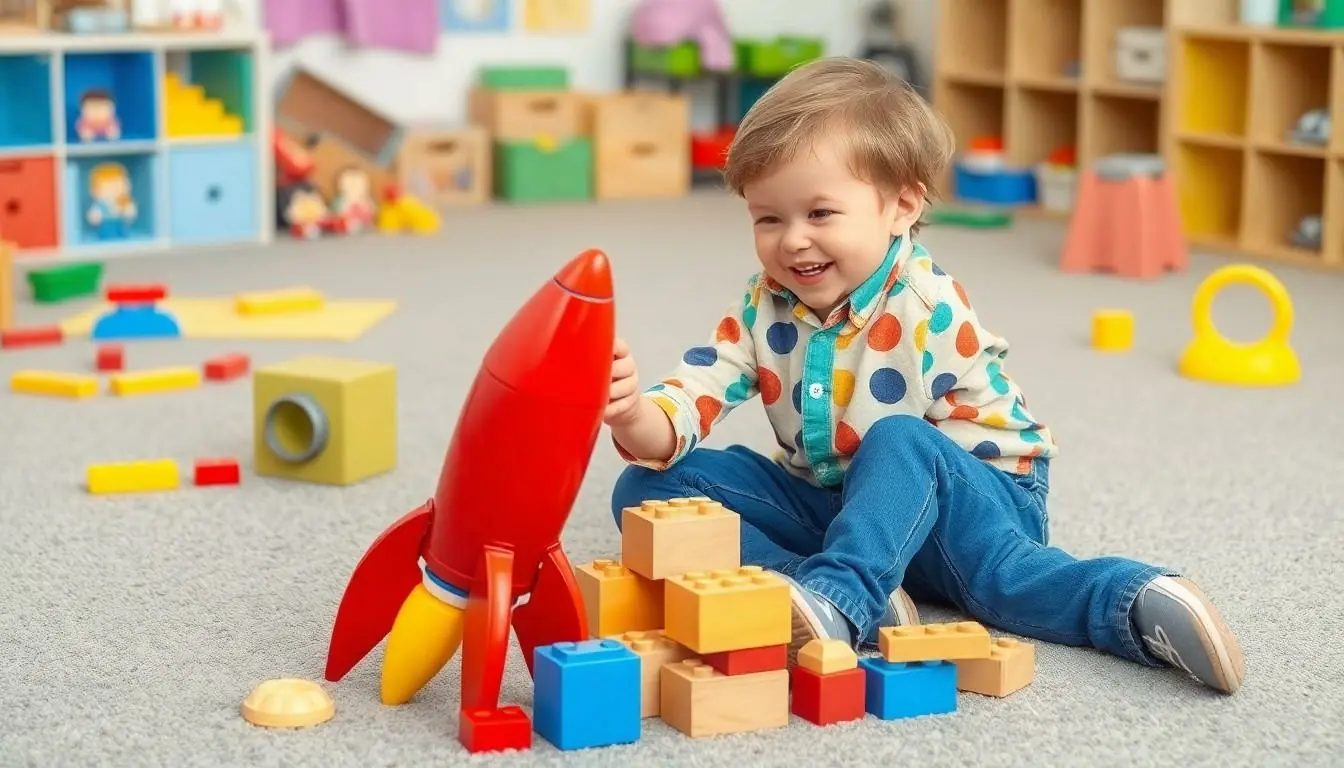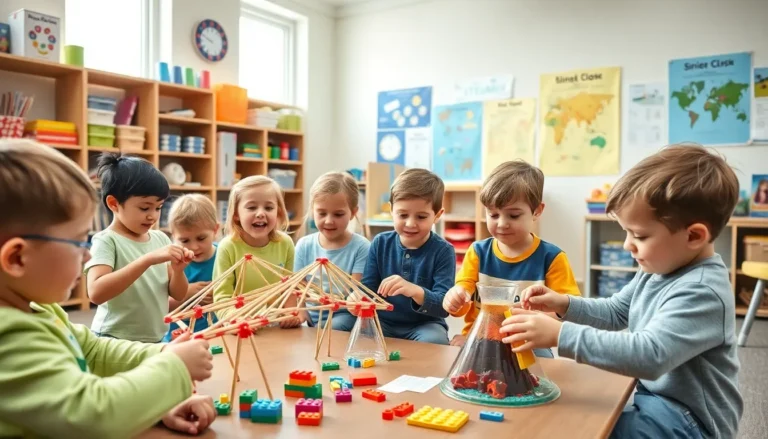Table of Contents
ToggleIn a world buzzing with technology and innovation, the seeds of curiosity need to be planted early. For kids aged 3 to 5, STEM activities aren’t just a fun way to pass the time; they’re the building blocks for future problem solvers and critical thinkers. Imagine your little one, covered in glitter and glue, creating a rocket that could launch them to the moon—or at least to the top of the refrigerator!
Overview of STEM Activities
STEM activities provide a playful avenue for children aged 3 to 5 to explore their surroundings. Engaging in hands-on experiences fosters curiosity and supports cognitive development. Activities like building blocks encourage spatial awareness while promoting fine motor skills.
Exploration often begins with simple experiments. For example, mixing baking soda and vinegar provides an entertaining introduction to chemical reactions. Creative play might include designing paper airplanes, allowing children to experiment with aerodynamics and gravity.
Outdoor activities, such as nature scavenger hunts, further enhance scientific inquiry. Observing plants, rocks, and insects promotes an understanding of the environment. Art projects using recycled materials can introduce engineering concepts, as children learn to construct and balance different structures.
Technological skills can develop through interactive apps designed for young learners. Many educational games teach coding basics or mathematical concepts in an engaging format. Group-based STEM activities encourage teamwork and communication, important skills for future collaboration.
When children participate in STEM activities, they build a foundation for lifelong learning. Crucial thinking and problem-solving abilities grow through practice. These enriching experiences set the stage for advanced learning in later stages of education.
Importance of STEM for Young Children
Introducing STEM activities to young children plays a crucial role in their early development. Engaging with Science, Technology, Engineering, and Mathematics fosters essential skills that support learning.
Cognitive Development
Cognitive development in early childhood is significantly enhanced through STEM activities. These experiences stimulate curiosity and encourage exploration. Engaging in hands-on projects, such as stacking blocks, aids in developing spatial awareness and fine motor skills. Children who experiment with simple science tasks, like observing plant growth, deepen their understanding of the natural world. Solving puzzles or navigating mazes during playtime sharpens critical thinking skills. Creative tasks, like drawing or building models, also promote imaginative thinking. Overall, these activities provide valuable opportunities for cognitive growth.
Problem-Solving Skills
Problem-solving skills emerge as children engage in STEM activities. Activities like creating structures with various materials challenge children to think critically and find solutions. Working on group projects strengthens cooperation and communication among peers. Testing hypotheses through basic science experiments allows children to experience trial and error firsthand, encouraging resilience. Simple coding games introduce logical thinking in a fun way. Children learn to navigate obstacles creatively while building confidence in their abilities. Emphasizing problem-solving from an early age lays the groundwork for future academic success.
Fun and Engaging STEM Activities for 3-5 Year Olds
STEM activities inspire curiosity and creativity in young children. Engaging 3-5 year olds in these activities supports cognitive growth and skill development.
Hands-On Experiments
Hands-on experiments spark excitement in little learners. Mixing baking soda and vinegar creates a fizzy reaction, capturing attention while teaching basic science concepts. Children observe the results, boosting their understanding of chemical reactions. Simple experiments, such as growing crystals or watching plants sprout, enhance critical thinking as kids ask questions about how things work. These engaging activities develop observation and reasoning skills, helping them connect with the world.
Creative Building Projects
Creative building projects encourage imaginative thinking. Children can construct with blocks, LEGO sets, or recycled materials, allowing them to explore engineering concepts. Stacking blocks promotes fine motor skills and spatial awareness while fostering creativity. Designing structures, like bridges or towers, invites experimentation with balance and stability. Through these projects, kids learn to problem-solve, adjust their designs, and appreciate the artistic aspect of engineering.
Nature-Based Exploration
Nature-based exploration fosters a connection to the environment. Outdoor activities, like nature scavenger hunts, allow children to identify local plants and animals, enhancing their scientific inquiry skills. Collecting leaves or observing insects encourages curiosity about biodiversity. Gardening projects, where children plant seeds and monitor growth, introduce concepts of life cycles and ecosystems. These hands-on experiences deepen their appreciation for nature while integrating essential STEM principles.
Tips for Implementing STEM Activities
Implementing STEM activities for young children requires careful consideration of the materials and environment.
Safe Materials and Environment
Safety stands as a priority when selecting materials for STEM activities. Non-toxic, child-friendly items such as wooden blocks, organic clay, or recycled cardboard promote safe exploration. Ensure activities occur in a clean, supervised space. Supervision allows for instant feedback and assistance. Arrange tables or work areas to encourage free movement and creativity. Soft surfaces like carpets or foam mats can prevent injuries during energetic play. Consistently check toys and materials for wear or damage, replacing them as necessary to maintain a safe learning environment.
Encouraging Curiosity and Exploration
Curiosity drives children’s engagement in STEM. Start by asking open-ended questions that spark interest in the activity. Create opportunities for hands-on experimentation. Allow children to manipulate materials freely. Observing their actions yields insights into their understanding of concepts. Encourage children to ask questions and hypothesize outcomes. Incorporating outdoor exploration, such as nature walks or garden projects, broadens scientific inquiry and connection to the environment. Stimulating their imagination through diverse activities enhances critical thinking and problem-solving skills. Each experience builds on their natural curiosity and willingness to learn more.
Conclusion
Introducing STEM activities to young children lays the groundwork for essential skills they’ll use throughout their lives. These engaging experiences not only spark curiosity but also promote critical thinking and problem-solving abilities. Through hands-on projects and creative play, children learn to explore and understand the world around them.
As they participate in various activities, they develop resilience and teamwork, crucial traits for future success. By fostering a love for inquiry and exploration at an early age, parents and educators can ensure that these young learners are well-prepared for the challenges ahead. Embracing STEM in early childhood education is a powerful step toward nurturing the innovators and thinkers of tomorrow.







